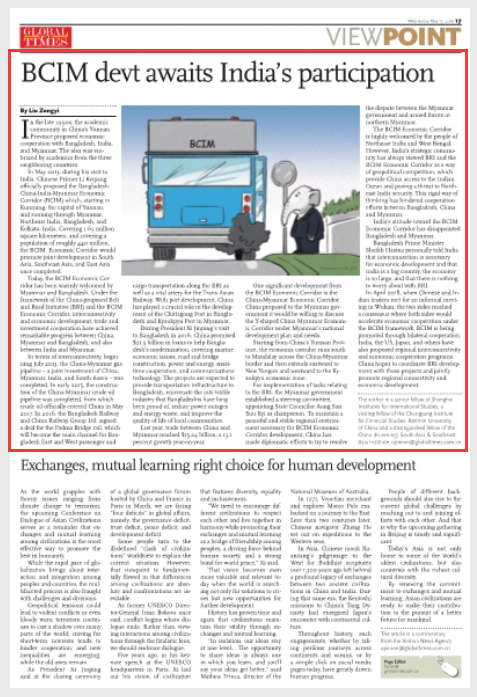Major Power Relations
Your Present Location: PROGRAMS> Major Power RelationsLiu Zongyi: BCIM devt awaits India’s participation
By Liu Zongyi Source: Global Times Published: 2019-5-14
In the late 1990s, the academic community in China's Yunnan Province proposed economic cooperation with Bangladesh, India, and Myanmar. The idea was embraced by academics from the three neighboring countries.

In May 2013, during his visit to India, Chinese Primer Li Keqiang officially proposed the Bangladesh-China-India-Myanmar Economic Corridor (BCIM) which, starting in Kunming, the capital of Yunnan, and running through Myanmar, Northeast India, Bangladesh, and Kolkata, India. Covering 1.65 million square kilometers, and covering a population of roughly 440 million, the BCIM Economic Corridor would promote joint development in South Asia, Southeast Asia, and East Asia once completed.
Today, the BCIM Economic Corridor has been warmly welcomed by Myanmar and Bangladesh. Under the framework of the China-proposed Belt and Road Initiative (BRI) and the BCIM Economic Corridor, interconnectivity and economic development, trade and investment cooperation have achieved remarkable progress between China, Myanmar and Bangladesh, and also between India and Myanmar.
In terms of interconnectivity, beginning July 2013, the China-Myanmar gas pipeline - a joint investment of China, Myanmar, India, and South Korea - was completed. In early 2015, the construction of the China-Myanmar crude oil pipeline was completed, from which crude oil officially entered China in May 2017. In 2016, the Bangladesh Railway and China Railway Group Ltd. signed a deal for the Padma Bridge rail, which will become the main channel for Bangladesh East and West passenger and cargo transportation along the BRI as well as a vital artery for the Trans-Asian Railway. With port development, China has played a crucial role in the development of the Chittagong Port in Bangladesh and Kyaukpyu Port in Myanmar.
During President Xi Jinping's visit to Bangladesh in 2016, China promised $21.5 billion in loans to help Bangladesh's modernization, covering marine economic issues, road and bridge construction, power and energy, maritime cooperation, and communications technology. The projects are expected to provide transportation infrastructure in Bangladesh, rejuvenate the jute textile industry that Bangladeshis have long been proud of, reduce power outages and energy waste, and improve the quality of life of local communities.
Last year, trade between China and Myanmar reached $15.24 billion, a 13.1 percent growth year-on-year.
One significant development from the BCIM Economic Corridor is the China-Myanmar Economic Corridor. China proposed to the Myanmar government it would be willing to discuss the Y-shaped China-Myanmar Economic Corridor under Myanmar's national development plan and needs.
Starting from China's Yunnan Province, the economic corridor runs south to Mandalay across the China-Myanmar border and then extends eastward to New Yangon and westward to the Kyaukpyu economic zone.
For implementation of tasks relating to the BRI, the Myanmar government established a steering committee, appointing State Councilor Aung San Suu Kyi as chairperson. To maintain a peaceful and stable regional environment necessary for BCIM Economic Corridor development, China has made diplomatic efforts to try to resolve the dispute between the Myanmar government and armed forces in northern Myanmar.
The BCIM Economic Corridor is highly welcomed by the people of Northeast India and West Bengal. However, India's strategic community has always viewed BRI and the BCIM Economic Corridor as a way of geopolitical competition, which provide China access to the Indian Ocean and posing a threat to Northeast India security. This rigid way of thinking has hindered cooperation efforts between Bangladesh, China and Myanmar.
India's attitude toward the BCIM Economic Corridor has disappointed Bangladesh and Myanmar.
Bangladesh Prime Minister Sheikh Hasina personally told India that interconnection is necessary for economic development and that India is a big country, the economy is so large, and that there is nothing to worry about with BRI.
In April 2018, when Chinese and Indian leaders met for an informal meeting in Wuhan, the two sides reached a consensus where both sides would accelerate economic cooperation under the BCIM framework. BCIM is being promoted through bilateral cooperation. India, the US, Japan, and others have also proposed regional interconnectivity and economic cooperation programs. China hopes to coordinate BRI development with these projects and jointly promote regional connectivity and economic development.
The author is a senior fellow of Shanghai Institutes for International Studies, a visiting fellow of the Chongyang Institute for Financial Studies, Renmin University of China and a distinguished fellow of the China (Kunming) South Asia & Southeast Asia Institute.























































































 京公网安备 11010802037854号
京公网安备 11010802037854号





